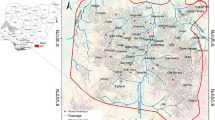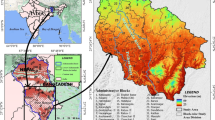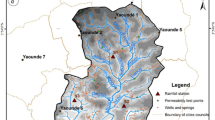Abstract
During the monsoon season, flooding is common in several parts of India, and urban areas are becoming more prone to flooding even during less intense rainfall events as a result of the encroachment of waterbodies and natural drainage channels, increased impervious areas, and subsequent decrease in infiltration capabilities. In the years 2000, 2008, 2016, 2019, 2020, and 2021, severe flood events in our study area, the Saroor Nagar urban watershed in Telangana state, caused human loss, economic devastation, and environmental devastation. Although flood risk cannot be completely eliminated, it can be significantly reduced by developing a flood hazard model to identify flood-prone areas in a watershed, which can assist decision makers seeking comprehensive flood risk management. The flood hazard map is created by integrating Geomatics with multi-criteria decision analysis and the analytical hierarchy process (AHP). Topographic wetness index (TWI), digital elevation model (DEM), slope, precipitation, drainage density, distance to waterbody, soil, and land use land cover (LULC) were the flooding causative elements considered in this study. The resulting flood risk map is divided into four distinct categories that reflect flood danger levels of low, moderate, high, and extremely high. The flood risk map revealed that the moderate risk zone decreased from 50.2 to 45.7% of the study area between 2008 and 2020, while the high-risk zone increased from 45.2 to 52.8%. The flood susceptibility map is validated using crowdsourcing techniques. The findings demonstrated that a Geographic Information System (GIS)-based multi-criteria analysis framework for flood hazard analysis could be effectively used to aid disaster management decision-making.















Similar content being viewed by others
Data availability
The authors confirm that the data supporting the findings of this study are available within the article.
References
Abebe Y, Kabir G, Tesfamariam S (2018) Assessing urban areas vulnerability to pluvial fooding using GIS applications and Bayesian belief network model. J Clean Prod 174:1629–1641. https://doi.org/10.1016/j.jclepro.2017.11.066http://www.sciencedirect.com/science/article/pii/S0959652617327245
Awawdeh M, Obeidat M, Al-Mohammad M, Al-Qudah K, Jaradat R (2014) Integrated GIS and remote sensing for mapping groundwater potentiality in the Tulul al Ashaqif. Arab J Geosci 7(6):2377–2392
Beltramone G, Alaniz E, Ferral AE, Aleksink A, Arijn DR, Bernasconi I, Germn A, Ferral A (2017) Risk mapping of urban areas prone to flash floods in mountain basins using the analytic hierarchy process and geographical information systems. In: 2017 XVII Workshop on information processing and control (RPIC), 1–6. https://doi.org/10.23919/RPIC.2017.8214379
Bisht S, Chaudhry S, Sharma S, Soni S (2018) Assessment of flash food vulnerability zonation through Geospatial technique in high altitude Himalayan watershed, Himachal Pradesh India. Remote Sens Appl: Soc Environ 12:35–47. https://doi.org/10.1016/j.rsase.2018.09.001
CetinkayaZceylanErbaKabak CEMM (2016) GIS-based fuzzy MCDA approach for siting refugee camp: a case study for south eastern Turkey. Int J Disaster Risk Reduct 18:218–231
Chakraborty S, Mukhopadhyay S (2019) Assessing flood risk using analytical hierarchy process (AHP) and geographical information system (GIS): application in Coochbehar district of West Bengal. Nat Hazards 99(1):247–274
Chen H, Ito Y, Sawamukai M, Tokunaga T (2015) Flood hazard assessment in the Kujukuri plain of Chiba prefecture, Japan, based on GIS and multicriteria decision analysis. Nat Hazards 78(1):105–120. https://doi.org/10.1007/s11069-015-1699-5
Das S, Pardeshi SD (2018) Comparative analysis of lineaments extracted from Cartosat, SRTM and ASTER DEM: a study based on four watersheds in Konkan region, India. Spatial Inform Res 26(1):47–57. https://doi.org/10.1007/s41324-017-0155-x
Das S (2018) Geographic information system and AHP-based flood hazard zonation of Vaitarna basin, Maharashtra, India. Arab J Geosci 11(19). https://doi.org/10.1007/s12517-018-3933-4.
Dash P, Sar J (2020) Identification and validation of potential flood hazard area using GIS based multi-criteria analysis and satellite data-derived water index. J Flood Risk Manag 13(3):e12620
Deng Z, Zhang X, Li D, Pan G (2015) Simulation of land use/land cover change and its effects on the hydrological characteristics of the upper reaches of the Hanjiang Basin. Environ Earth Sci 73(3):1119–1132
Dou X, Song J, Wang L, Tang B, Xu S, Kong F, Jiang X (2018) Flood risk assessment and mapping based on a modified multi-parameter flood hazard index model in the Guanzhong Urban Area. Stoch Environ Res Risk Assess 32(4):1131–1146
EbrahimianGhajari Y, Alesheikh AA, Modiri M, Hosnavi R, Abbasi M, Sharifi A (2018) Urban vulnerability under various blast loading scenarios: analysis using GIS-based multi-criteria decision analysis techniques. Cities 72:102–114. https://doi.org/10.1016/j.cities.2017.08.006
Elkhrachy I (2015) Flash flood hazard mapping using satellite images and GIS tools: a case study of Najran City, Kingdom of Saudi Arabia (KSA). Egypt J Remote Sens Space Sci 18(2):261–278. https://doi.org/10.1016/j.ejrs.2015.06.007 (http://www.sciencedirect.com/science/article/pii/S1110982315000307)
Elsheikh RFA, Ouerghi S, Elhag AR (2015) Flood risk map based on GIS, and multi criteria techniques (case study Terengganu Malaysia). J Geogr Inf Syst 7(04):348–357
Epicollect5 Data Collection User Guide. https://epicollect5.gitbooks.io/epicollect5-user-guide. Accessed 14 June 2022
Gambini JM, Laymito JA (2019) Multiparametric ahp-based flood hazard zonation approach in northwestern Peru at basin scale. E-Proceedings of the 38th IAHR World Congress, September 1-6, 2019, Panama City, Panama
Ghosh A, Kar S (2018) Application of analytical hierarchy process (AHP) for flood risk assessment: a case study in Malda district of West Bengal. Nat Hazards 94(1):349–368
Goepel K (2013) Implementing the analytic hierarchy process as a standard method for multi-criteria decision making in corporate enterprises a new AHP excel template with multiple inputs. Proceedings of the International Symposium on the Analytic Hierarchy Process, Kuala Lumpur. https://doi.org/10.13033/isahp.y2013.047
Hadi Allafta and Christian Opp (2021) GIS-based multi-criteria analysis for flood prone areas mapping in the trans-boundary Shatt Al-Arab basin, Iraq-Iran. Geomatics Nat Hazard Risk 12(1):2087–2116. https://doi.org/10.1080/19475705.2021.1955755
Hammami S, Zouhri L, Souissi D, Souei A, Zghibi A, Marzougui A, Dlala M (2019) Application of the GIS based multi-criteria decision analysis and analytical hierarchy process (AHP) in the flood susceptibility mapping (Tunisia). Arab J Geosci 12(21). https://doi.org/10.1007/s12517-019-4754-9.
Islam M, Sado K (2000) Flood hazard assessment for the construction of flood hazard map and land development priority map using NOAA/AVHRR data and GIS–a case study in Bangladesh. Hydrol Sci J Des Sci Hydrol 45(3):337–357
Lee MJ, Kang JE, Jeon S (2012) Application of frequency ratio model and validation for predictive flooded area susceptibility mapping using GIS. 895–898. Paper presented at 2012 32nd IEEE International Geoscience and Remote Sensing Symposium, IGARSS 2012, Munich, Germany. https://doi.org/10.1109/IGARSS.2012.6351414
Lei W, Dong H, Chen P, Lv H, Fan L, Mei G (2020) Study on runoff and infiltration for expansive soil slopes in simulated rainfall. Water 12(1):222
Liang Q, Xia X, Hou J (2016) Catchment-scale high-resolution flash flood simulation using the GPU-based technology. Procedia Eng 154:975–981. https://doi.org/10.1016/j.proeng.2016.07.585
Machiwal D, Rangi N, Sharma A (2015) Integrated knowledge- and data-driven approaches for groundwater potential zoning using GIS and multi-criteria decision-making techniques on hard-rock terrain of Ahar catchment, Rajasthan, India. Environ Earth Sci 73(4):1871–1892
Mahmoud S, Gan TY (2018) Multi-criteria approach to develop flood susceptibility maps in arid regions of Middle East. J Clean Prod 196:216–229. https://doi.org/10.1016/j.jclepro.2018.06.047
Mishra K, Sinha R (2020) Flood risk assessment in the Kosi megafan using multi-criteria decision analysis: a hydro-geomorphic approach. Geomorphology 350:106861. https://doi.org/10.1016/j.geomorph.2019.106861
Mojaddadi H, Pradhan B, Nampak H, Ahmad N, Ghazali AHB (2017) Ensemble machine-learning-based geospatial approach for flood risk assessment using multi-sensor remote-sensing data and GIS. Geomatics Nat Hazard Risk 8:1080–1102
Munjuluri Kalyan, Pal Indrajit, Tripathi Nitin Kumar (2019) Geo-spatial techniques for rapid Post Disaster Needs Assessment (rPDNA). Int J Recent Technol Eng (IJRTE) 8(4):11198–11206. https://doi.org/10.35940/ijrte.D8017.118419. ISSN: 2277–3878 (Online)
Nott J (2006) Extreme events: a physical reconstruction and risk assessment. Cambridge University Press, Cambridge
Nyarko BK (2002) Application of a rational model in GIS for flood risk assessment in Accra. Ghana J Spat Hydrol 2:1–14
Ogato G, Bantider A, Abebe K, Geneletti D (2020) Geographic information system (GIS)-Based multicriteria analysis of flooding hazard and risk in Ambo Town and its watershed, West Shoa zone, Oromia regional State Ethiopia. J Hydrol Regional Studies 27:100659
Ouma YO, Tateishi R (2014) Urban flood vulnerability and risk mapping using integrated multi-parametric AHP and GIS: methodological overview and case study assessment. Water 6(6):1515–1545. https://doi.org/10.3390/w6061515
Papaioannou G, Vasiliades L, Loukas A (2015) Multi-criteria analysis framework for potential flood prone areas mapping. Water Resour Manag 29(2):399–418. https://doi.org/10.1007/s11269-014-0817-6
Poussin JK, Botzen WW, Aerts JC (2014) Factors of influence on flood damage mitigation behavior by households. Environ Sci Pol 40:69–77 Journal (2019), Article ID 3814962, 7
Price K, Jackson CR, Parker AJ (2010) Variation of surficial soil hydraulic properties across land uses in the southern Blue Ridge Mountains, North Carolina, USA. J Hydrol 383(3–4):256–268
Quan RS, Liu M, Lu M, Zhang LJ, Wang JJ, Xu SY (2010) Waterlogging risk assessment based on land use/cover change: a case study in Pudong new area, shanghai. Environ Earth Sci 61(6):1113–1121. https://doi.org/10.1007/s12665-009-0431-8
Radmehr A, Araghinejad S (2015) Flood vulnerability analysis by fuzzy spatial multi criteria decision making. Water Resour Manage 29(12):4427–4445
Rahman M, Ningsheng C, Islam M, Dewan A, Iqbal J, Washakh R, Shufeng T (2019) Flood susceptibility assessment in Bangladesh using machine learning and multi criteria decision analysis. Earth Syst Environ 3(3):585–601
Rahmati O, Zeinivand H, Besharat M (2015) Flood hazard zoning in Yasooj region, Iran, using GIS and multi-criteria decision analysis. Geomat Nat Haz Risk 7(3):1000–1017. https://doi.org/10.1080/19475705.2015.1045043
Rahmati O, Pourghasemi HR, Zeinivand H (2016) Flood susceptibility mapping using frequency ratio and weights of-evidence models in the Golastan Province, Iran. Geocarto Int 31(1):42–70
Rajasekhar M, Sudarsana Raju G, Sreenivasulu Y, Siddi Raju R (2019) Delineation of groundwater potential zones in semi-arid region of Jilledubanderu river basin, Anantapur District, Andhra Pradesh, India using fuzzy logic, AHP and integrated fuzzy-AHP approaches. HydroResearch 2:97–108. https://doi.org/10.1016/j.hydres.2019.11.006
RazaviTermeh SV, Kornejady A, Pourghasemi HR, Keesstra S (2018) Flood susceptibility mapping using novel ensembles of adaptive neuro fuzzy inference system and metaheuristic algorithms. Sci Total Environ 615:438–451. https://doi.org/10.1016/j.scitotenv.2017.09.262
Riad P, Billib M, Hassan A, Salam M, El Din M (2011) Application of the overlay weighted model and boolean logic to determine the best locations for artificial recharge of groundwater. JUEE 5(2):57–66
Saaty T (1980) The analytic hierarchy process, xiii edn. McGraw-Hill International Book Co., New York
Saaty T (1990) How to make a decision: the analytic hierarchy process? Eur J Oper Res 48(1):9–26
Saaty TL (2008) Decision making with the analytic hierarchy process. Int J Serv Sci 1(1):83–98
Saaty T (2014) Decision making for leaders: the analytic hierarchy process for decisions in a complex world. RWS Publications, Pittsburgh
Sabzi HZ, Humberson D, Abudu S, King JP (2016) Optimization of adaptive fuzzy logic controller using novel combined evolutionary algorithms, and its application in Diez Lagos flood controlling system, southern new Mexico. Expert Syst Appl 43:154–164
Sadeghi-Pouya A, Nouri J, Mansouri N, Kia-Lashaki A (2017) An indexing approach to assess flood vulnerability in the western coastal cities of Mazandaran, Iran. Int J Disaster Risk Reduct 22:304–316. https://doi.org/10.1016/j.ijdrr.2017.02.013
Saha AK, Agrawal S (2020) Mapping and assessment of flood risk in Prayagraj district, India: a GIS and remote sensing study. Nanotechnol Environ Eng 5:11. https://doi.org/10.1007/s41204-020-00073-1
Sahana M, Sajjad H (2019) Vulnerability to storm surge food using remote sensing and GIS techniques: a study on Sundarban Biosphere Reserve, India. Remote Sens Appl: Soc Environ 13:106–120. https://doi.org/10.1016/j.rsase.2018.10.008
Salleh S, Rahman AAA, Othman A, Mohd WNW (2018) Comparative study of landslides susceptibility mapping methods: multi-criteria decision making (MCDM) and artificial neural network (ANN). In: IOP conference series: earth and environmental science, IOP Publishing. https://doi.org/10.1088/1755-1315/117/1/012035
Samanta RK, Bhunia GS, Shit PK, Pourghasemi HR (2018) Flood susceptibility mapping using geospatial frequency ratio technique: a case study of Subarnarekha River Basin. Model Earth Syst Environ 4(1):395–408
Sarker MZ, Sivertun Å (2011) GIS and RS combined analysis for flood prediction mapping– a case study of Dhaka City corporation. IJEP 1(3):30–42
Sauer VB (2002) USGS, the national flood frequency program, version 3: a computer program for estimating magnitude and frequency of floods for ungaged sites
Schmitt TG, Thomas M, Ettrich N (2004) Analysis and modeling of flooding in urban drainage systems. J Hydrol 299(3–4):300–311
Sheena AD, Ramalingam M, Anuradha B (2019) Remote sensing and GIS in the recent Chennai food study. Nanotechnol Environ Eng 4:3. https://doi.org/10.1007/s41204-018-0049-8
Siahkamari S, Haghizadeh A, Zeinivand H, Tahmasebipour N, Rahmati O (2018) Spatial prediction of flood-susceptible areas using frequency ratio and maximum entropy models. Geocarto Int 33(9):927–941. https://doi.org/10.1080/10106049.2017.1316780
Subbarayan S, Sivaranjani S (2020) Modelling of flood susceptibility based on gis and analytical hierarchy process—a case study of Adayar River Basin, Tamilnadu, India. In: Pal I, von Meding J, Shrestha S, Ahmed I, Gajendran T (eds) An interdisciplinary approach for disaster resilience and sustainability. MRDRRE 2017. Disaster Risk Reduction (Methods, Approaches and Practices). Springer, Singapore
Subramanian N, Ramanathan R (2012) A review of applications of analytic hierarchy process in operations management. Int J Prod Econ 138(2):215–241
Tang X, Shu Y, Lian Y, Zhao Y, Fu Y (2018) A spatial assessment of urban waterlogging risk based on a weighted nave bayes classifier. Sci Total Environ 630:264–274. https://doi.org/10.1016/j.scitotenv.2018.02.172
Tehrany MS, Pradhan B, Jebur MN (2013) Spatial prediction of flood susceptible areas using rule-based decision tree (dt) and a novel ensemble bivariate and multivariate statistical models in GIS. J Hydrol 504:69–79. https://doi.org/10.1016/j.jhydrol.2013.09.034
Tehrany MS, Pradhan B, Mansor S, Ahmad N (2015) Flood susceptibility assessment using GIS-based support vector machine model with different kernel types. Catena 125:91–101. https://doi.org/10.1016/j.catena.2014.10.017
Todini F, De Filippis T, De Chiara G, Maracchi G, Martina M, Todini E (2004) Using a GIS approach to asses flood hazard at national scale. In: Proceedings of the European Geosciences Union, 1st General Assembly, Nice, pp 25–30
Ullah K, Zhang J (2020) GIS-based flood hazard mapping using relative frequency ratio method: a case study of Panjkora River Basin, eastern Hindu Kush. Pakistan Plos One 15(3):e0229153
Vaddiraju SC, Reshma T (2022) Urbanization implications on hydro-meteorological parameters of Saroor Nagar Watershed of Telangana. Environ Challenges 8:100562. https://doi.org/10.1016/j.envc.2022.100562. ISSN 2667–0100
Vishnu CL, Sajinkumar KS, Oommen T et al (2019) Satellite-based assessment of the August 2018 flood in parts of Kerala, India. Geomat Nat Hazards Risk 10:758–767. https://doi.org/10.1080/19475705.2018.1543212
Wang Y, Li Z, Tang Z, Zeng G (2011) A GIS-based spatial multi-criteria approach for flood risk assessment in the Dongting Lake Region, Hunan, Central China. Water Resour Manag 25(13):3465–3484
Wu Y, Zhong P, Zhang Y, Xu B, Ma B, Yan K (2015) Integrated flood risk assessment and zonation method: a case study in Huaihe River basin. Nat Hazards 78(1):635–651
Xiao Y, Yi S, Tang Z (2017) Integrated flood hazard assessment based on spatial ordered weighted averaging method considering spatial heterogeneity of risk preference. Sci Total Environ 599–600(2017):1034–1046
Yan B, Fang NF, Zhang PC, Shi ZH (2013) Impacts of land use change on watershed streamflow and sediment yield: an assessment using hydrologic modelling and partial least squares regression. J Hydrol 484:26–37
Zhao G, Pang B, Xu Z, Yue J, Tu T (2018) Mapping flood susceptibility in mountainous areas on a national scale in China. Sci Total Environ 615:1133–1142. https://doi.org/10.1016/j.scitotenv.2017.10.037
Zou Q, Zhou J, Zhou C, Song L, Guo J (2013) Comprehensive food risk assessment based on set pair analysis-variable fuzzy sets model and fuzzy AHP. Stoch Environ Res Risk Assess 27(2):525–546. https://doi.org/10.1007/s00477-012-0598-5
Author information
Authors and Affiliations
Contributions
All authors contributed to the study conception and design. Material preparation, data collection, and analysis were performed by Shiva Chandra Vaddiraju. The first draft of the manuscript was written by Shiva Chandra Vaddiraju, and Reshma Talari suggested improvements in the manuscript. All authors read and approved the final manuscript.
Corresponding author
Ethics declarations
Ethics approval
Not applicable.
Consent to participate
Not applicable.
Consent for publication
Not applicable.
Competing interests
The authors declare no competing interests.
Additional information
Responsible Editor: Marcus Schulz
Publisher's note
Springer Nature remains neutral with regard to jurisdictional claims in published maps and institutional affiliations.
Rights and permissions
Springer Nature or its licensor (e.g. a society or other partner) holds exclusive rights to this article under a publishing agreement with the author(s) or other rightsholder(s); author self-archiving of the accepted manuscript version of this article is solely governed by the terms of such publishing agreement and applicable law.
About this article
Cite this article
Vaddiraju, S.C., Talari, R. Urban flood susceptibility analysis of Saroor Nagar Watershed of India using Geomatics-based multi-criteria analysis framework. Environ Sci Pollut Res 30, 107021–107040 (2023). https://doi.org/10.1007/s11356-022-24672-4
Received:
Accepted:
Published:
Issue Date:
DOI: https://doi.org/10.1007/s11356-022-24672-4




